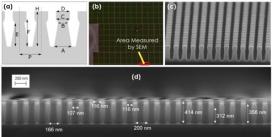Home / Advances Enable Speed Gains in Organizing and Analyzing Nanomanufacturing Data
Advances Enable Speed Gains in Organizing and Analyzing Nanomanufacturing Data
Outcome/accomplishment:
Advanced tools for organizing and mining big sensor and metrology data in nanomanufacturing were developed using first-principle based physics and Machine Learning (ML) concepts at the Nanomanufacturing Systems Center (NASCENT), an NSF-funded Engineering Research Center (ERC) based at the University of Texas at Austin.
Impact/benefits:
The advanced database technologies will enable fast-inspection techniques for real-time defect detection, characterization, and analysis of nanomanufacturing processes. The new approaches to data manipulation will help enable the real-time feedback and fault diagnostics needed for scaled-up production of tiny metal components.
Explanation/Background:
NASCENT research enabled compression of raw data below 10% of the original size, in a way that facilitates its direct mining in its compressed state, avoiding the time-consuming decompression of data and extraction of informative features using subjective and error-prone human expertise. Furthermore, it enabled organization of metrology and sensor data into database structures that can be searched with logarithmic speed gains, which further accelerates all data mining efforts.
Finally, new database organization approaches were combined with advanced machine-learning methods to scale up and process optical metrology of nanopatterned surfaces in minutes instead of hours or even days, which enables continuous in-process metrology of entire 300mm wafers. Such fast metrology was accomplished with Gage Repeatability and Reproducibility of 10% or less, which matches that of Scanning Electron Microscopy.


